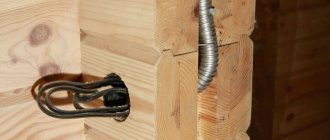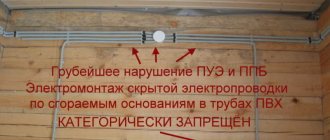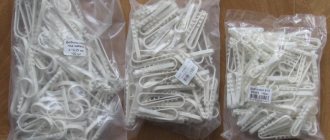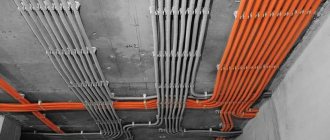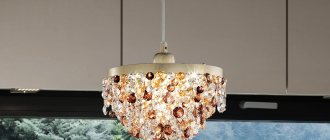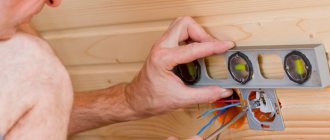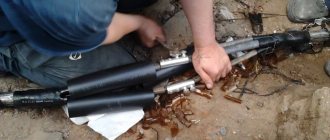For every property owner, sooner or later there comes a time when he needs to decide which electrical wiring will be most optimal in his building. Someone decides to spend an unreasonably large amount of money on installing cables in a corrugated pipe, thereby enriching the contractor. Some people, in order to save money, decide to ignore regulations, putting people’s lives in danger, and install electrical wiring without corrugation. Let's try to understand all the nuances and find out: what kind of wiring should be in the room and how to make it safe without spending extra money.
Is it necessary to use corrugation when laying electrical cables and wires?
Is corrugation needed when laying cables or can electrical wiring be done without it? This simple question, although it has a fairly firm answer in the regulatory documentation, in particular in the PUE (Electrical Installation Rules), still causes a storm of fierce debate, which often misleads many people who are faced with replacing electrical wiring for the first time.
Moreover, this situation is fueled, it seems, by experienced electricians who receive a lot of money for their work and often, consciously or not, impose on their customers a method of laying cables that is not always justified.
Errors and rules for cable installation
The most common mistakes made by electricians when laying cable networks stretched inside the corrugation are:
- Creating sharp corners.
It is necessary to lay the routes in such a way that the corner transitions are flexible. Sharp corners should not be allowed when turning.
- No special components are used to increase the length.
When you need to make an entire section of wiring longer, you need to use tees, transit boxes, and couplings.
- The corrugation is connected using electrical tape.
According to the PUE, it is unacceptable to connect 2 corrugated pipes with each other using insulating tape. There are connecting components for this. This applies to turns, corners, and the middle of a long section.
- One corrugation has been laid, into which several lines of power cables are stretched.
This is a very serious mistake made by electricians. According to the PUE, it is correct when each cable power line is pulled into a separate corrugated pipe. It is unacceptable to lay several conductors in a corrugated cable at once.
Wiring output Source arte.net.ua
Cable without corrugation. Why not and when is possible.
Anyone who is faced with installing electrical wiring in a house always asks three questions:
- Do I need corrugation on the ceiling?
- Do you need corrugation in the walls?
- and third, the most important, is it possible to lay a cable without corrugation at all?
As they say, the rules of the PUE, clause 7.1.37, embedding a bare cable in a groove is allowed. But in the same rules there is an explanation of what the word allowed means:
It turns out that theoretically you can use the cable in walls without protection, and the rules leave you a loophole for this. The main thing is to legally justify why you did it this way and not otherwise.
Moreover, in the updated set of rules SP 256.1325800.2016 “Electrical installations of residential and public buildings. Design and Installation Rules” plainly states:
That is, it is possible to plaster not only the cable, but also separately the wires in the protective sheath.
What about laying on the ceiling, without plaster? Here we look at paragraph 15.15 from the same code:
And here, too, it is clearly stated that it is allowed to lay individual cables along the ceiling on brackets, i.e. without any corrugation.
At the same time, there are several practical considerations that clearly show that laying a cable without corrugation cannot be considered a durable installation.
Many walls tend to crack over time. This is especially noticeable in secondary housing.
If you have seen walls cleared of wallpaper, be it a panel house or a brick one, then you have probably noticed various kinds of cracks. They may be no thicker than a hair, or vice versa, a thumb can easily fit there.
In addition, cracks are also found in new buildings, even in those that have not yet been occupied by residents. Now think about what happens to the cable tightly sealed in the wall when it moves apart.
Most likely, nothing good. Will you be able and will you want, 15-20 years after such cracks appear, to tear off the wallpaper and change all the supply wiring?
Imagine that you needed to hang one or more paintings on the wall a few years after the renovation.
You take a hammer drill, mark the fastening points, start drilling and hear a characteristic pop with the release of a large number of sparks.
And only then do you remember about the cable going to the socket hidden behind the bedside table. It is useless to turn on the machine; there will be a stable short circuit on the line. And all the other sockets in the room can hang on this group.
If you have suspended ceilings installed, then in principle there is no question of replacing the damaged area, but under one condition - if the cable is laid in a corrugated area.
You can easily replace this piece by simply unfastening part of the ceiling, running a new cable and zipping it back up. At the same time, there is no chiselling or breaking into walls.
On the ceiling itself, when turning at 90 degrees, this trick is unlikely to succeed.
Imagine that with all of the above, the cable is embedded in the plaster? You can, of course, not open the walls, but simply abandon this outlet (by biting off the connection to it under the ceiling).
But then get your longest carriers and extensions ready for unsheathing.
Very often in old houses you can find dirty cable marks on the walls. These are dark rusty stripes along which the wiring routes can be easily traced.
These stripes can be so visible that they sometimes even show through several layers of wallpaper.
Of course, the Gost cable VVGnG-Ls does not necessarily have to give such an effect, but you will not get a definite answer until you are convinced of the quality of this or that product from personal experience.
Moreover, the effect may not appear immediately, but after 10-15 years. In addition, don't forget:
Corrugation on the ceiling
Proponents of laying electrical wires along the ceiling without protection give three arguments:
- installation of the cable on the ceiling without corrugation is allowed
- saves a lot of money
- saves time on the work itself
In this case, we almost always mean laying cables in bundles.
And along with the beams, you immediately need to remember about the reduction factor. Regulatory documents GOST R50571.5.52-2011 table C.52.3 actually oblige the installation of circuit breakers with a lower rating when laying cables in bundles.
That is, for example, you will no longer have a 16A switch per socket, but only 10A. Or you will have to increase the cross-section of the cable and use not 2.5mm2, but all 4mm2.
As a result, you end up with unrealized power reserves on sockets or cables.
Corrugation. Use when laying on the floor/ceiling
Since my last post, I found out that many people do not understand the essence and purpose of corrugation when used in electrical installations. Well, let's try to figure it out in more detail.
HDPE and PVC pipes are mainly used:
-Gray is non-flammable and self-extinguishing, unlike black
-Grey is fragile, while black, on the contrary, is much more resistant to mechanical damage
-The gray one is 2 times cheaper than the black one
When laying electrical wiring, corrugated cables should be used, but in each individual case the choice depends on the wiring method.
There are 3 types of wiring (I'm talking about hidden):
Let's start with the last one.
-When laying on walls, the use of corrugation is not necessary, since the installation is carried out in a non-combustible ceiling; accordingly, corrugation is needed only for protection from the mechanical and chemical effects of finishing materials, or for replacing the cable.
In practice, it is practically impossible to stretch a cable even 2 meters long; when using standard corrugation (16-20mm), there will be no mechanical impacts, since finishing materials do not create shrinkage and stress, and not a single corrugation or chemical impact will save you from a hammer drill The cable is not afraid of finishing materials. Thus, we come to the conclusion that the use of corrugation is not necessary when laying on walls.
Ceiling distribution.
-When wiring to the ceiling, which will then be covered with a ceiling (tension), it is necessary to use corrugation or a ready-made cable in a non-flammable braid (VVGng-LS for example). It is acceptable to use gray PVC corrugation, since it is self-extinguishing, however, you can simply use a ready-made cable without corrugation, since its braiding serves as a protection and is also self-extinguishing. It is also possible to use HDPE pipes if a ready-made non-flammable cable is used.
Floor distribution.
-When laying on the floor, cable protection is necessary, primarily from mechanical damage due to drying of the screed. When it dries, stresses are created that can damage the cable/wire and tear the insulation on it. The corrugation plays the role of a damper, thereby preventing it from affecting the cable/wire. You can also use both (PVC and HDPE) options, however, as a rule, after completing the electrical work, quite a bit of time will pass before pouring, and during the process, workers will walk on the wires and simply trample on it, which will reduce the effectiveness of damping. If you are sure that no one will go, then please use gray, or gray, but high-quality (DKS, Ruvinyl), and not rags from the market for 500 rubles. And HDPE pipe is also ideal; it cannot be trampled. Replacing the cable when laying on the floor is not possible when using corrugation sizes of 16-20mm.
Is corrugation necessary?
In order to understand whether it is dangerous or not to install electrical wiring without corrugation and which cable is most suitable for this purpose, consider GOST R 53315-2009 (GOST 31565 - 2012).
The document states that wiring in residential premises can be carried out using a cable with copper conductors and a flame retardant sheath with low gas and smoke emissions.
Such a conductor is VVG-ng-LS, or its analogues with an even higher degree of protection.
To figure out whether it is possible to do without corrugation when laying the VVGng-LS cable, let’s turn to the standards prescribed in PUE 7 (Rules for the Construction of Electrical Installations).
The table shows that wiring of the VVGng-LS cable, which belongs to protected wires and cables with a sheath made of fire-resistant materials, can be carried out:
- openly – directly on structures made of any materials,
- hidden - on fire-resistant substrates.
In other words, in these cases, additional protection is not required; you can do without corrugation.
The exception is hidden wiring on combustible bases. In this case, a lining made of “non-combustible materials” is required.
To understand whether the use of electrical corrugated pipes can enhance the fire safety of wiring, let’s consider their characteristics.
From the technical information offered by the manufacturer, it is clear that in terms of fire resistance, PVC corrugation “does not support combustion” in the same way as VVGng-LS. From which we can conclude that wiring with this cable can be carried out without corrugation, which will reduce the cost of work and materials used, as well as reduce installation time.
In other words, in the case of laying a cable with a flame retardant sheath, the use of corrugated pipes is not financially justified, since it is enough to lay a cable marked “ng-LS”. If the wiring must pass through combustible structures, installation must be carried out in a metal pipe.
Wiring in the ceiling: pros and cons
There are several situations when such installation remains the only solution that can solve the problem:
- During subsequent installation of suspended ceilings made of plasterboard.
The corrugations and cables running along the top will be hidden behind the suspended ceiling. Drywall does not have to be used over the entire area. Let us assume that such a scheme is used in some areas.
- The room has already been filled with ready-made screed, which satisfies the characteristics.
There is no point in re-flooding the floor or ceiling if the quality of the surface is initially at the required level.
- There is no desire to change the floor covering that is already installed.
The main disadvantage is that the height of the room is reduced when using suspended ceilings. But this method has many more positive aspects:
- Easy distribution of components throughout the room.
- Trouble-free maintenance, replacement of parts if necessary.
- Safety. You don’t even need to remember the location details.
- Simplification of further connection of lighting devices.
Laying corrugated cable
The finished corrugated pipe is laid along the ceiling using special clips. The diameter of this part is selected taking into account the cross-section of the selected material. This option for attaching a corrugated pipe to the ceiling looks more aesthetically pleasing. For invisible, internal places, special metal brackets are mainly used. These parts are secured using electrical dowels.
To connect 2 corrugated pipes, couplings are used. They are cheap. In the case where in this section an integral cable line that does not have connections is stretched inside the corrugated protection, according to the PUE, those sections where the pipe is attached to the coupling are allowed to be sealed with a sealant. Otherwise, you need to choose other insulation methods that are considered the most reliable. When laying, do not bend the corrugated pipe too much. The acceptable parameter is printed by the manufacturer on the packaging box of the material.
Corrugation in section Source media2.24aul.ru
Basic rules for installing wiring in the ceiling
Electrical installation is carried out only on the basis of a pre-drawn plan, divided into parts and combined into one project.
When preparing papers, perform the following steps one by one:
- They determine the place from where electricity is supplied to the local area.
- Points where electricity is consumed are identified.
- Select an installation location for the protection components.
- Draw up diagrams for laying cables between entry points and consumers. The components from the previous paragraph are taken into account.
At the preliminary stage, you need to choose the method of work that will be optimal. The brand and cross-section of the cable are selected from special tables.
The installation method itself can be hidden or external.
The following additional recommendations help to avoid mistakes during work:
- It is advisable to lay electrical wiring in special protective corrugations. If this requirement is not met, there is a high probability of short circuits.
- Electrical appliances in the apartment are prohibited from being connected to one protection device. This is a bad option for further operation, even if the load does not exceed the standards. The appliances will turn off simultaneously when a short circuit occurs.
- Only the phase wire is broken by all switches. Otherwise, even the procedure for replacing light bulbs ends with an electric shock.
- It is unacceptable for the wires to touch or intersect each other.
- It is important to choose correctly not only the main type of wires, but also the cross-section.
- Special electrical boxes are used in bathrooms and kitchens.
- The cables are laid so that further stages of work do not cause problems.
Tree
Cables under such circumstances are pulled through steel pipes. Then fixing the products does not cause any trouble. The diameter should be such that the wiring fits easily inside.
For distribution pipes, it is important to use materials that are resistant to fire. Metal becomes the best choice for any situation. A layer of insulators is placed on the inner sides of such products, which will prevent the box and the current carrier from coming into contact with each other.
The work is carried out by performing the following actions:
- The drawing is transferred to the surface from a paper drawing. Cable installation lines are marked as accurately as possible.
- Next, distribution boxes are installed.
- The tubes are cut until the length is sufficient. At the next stage, these structures are fixed to the base on the ceiling.
- The individual parts of the pipes are connected, the standard option is welding.
- Cables are laid through pipes using pulling.
- Then they are discharged into the distribution box. The main thing is to leave the ends free, at least 20 cm.
- All wires are connected. The structure is wrapped with electrical tape and fixed.
- Afterwards, a functional check is allowed.
Concrete
In this case, cutting grooves. A special cutting tool equipped with diamond discs is used to help process the stone. Slotting types of devices (hammer, impact drill) are also needed, but only for hard-to-reach surfaces. The wider the groove, the better.
- Compared to the thickness of cables without protection, the depth of the groove is 2-3 times greater. Let us assume that the diameter of the protective shell is ½ larger.
- Cable laying is free. There is no tension.
- It is easy to check the depth indicator using a spatula attached to the wall.
- The groove section is covered only after the wiring is finally secured to the section. And on each side there is 1.5 meters in reserve.
Drywall
Restricted access to the base base is the main feature of ceilings made from this particular material. It is important to think in advance about where the points for prevention and inspection will be. Taking into account the type of base floor, the installation method is selected.
With a suspended ceiling made of plasterboard, the rack systems are successfully hidden inside. Therefore, open installation is allowed. The main thing is that all the wires in this case are located outside the structure.
Stretch ceiling
The stages of work are the same as in the case of drywall. Create a surface, subsequent access to which is limited. Not forgetting that there must be sufficient distance between the fixed corrugation and the ceiling. Otherwise, the corrugated surface of the structure installed on the ceiling opens to the eye.
Pass-through and distribution boxes are located outside the structure.
How to attach the corrugation to the ceiling?
To fasten corrugations with a cross-section from 16 to 25 mm, special clips are used. They come in 2 types:
- Open.
This type of clip looks like curved flat horns. The part holds the corrugated pipe due to its elasticity. On the side, the clips are equipped with couplings that allow you to connect them to each other. This makes installation and further maintenance of the electrical network easier.
Models with latches are used for corrugations with a diameter of more than 40 mm, as well as when installing cables along the ceiling.
- Closed.
This type of clip is similar to a simple clamp. The part presses the corrugated pipe to the surface to which it is attached. The process can be mechanized using a mounting gun. A clip of clips is placed there, then the electrician “shoots” the corrugation to the ceiling.
Electrical panel Source verchinskiy.ru
How to conduct electrical wiring under a cassette structure yourself
Unimpeded access to the rough part is the main advantage that distinguishes this option from others. Therefore, there is no need to move the boxes outside the structure. Decorative trim is often used to hide everything.
The pipes are fixed to the base with brackets or clamps if the open option is selected.
It is important to adhere to the following rules when talking about a closed version.
- For metal or reinforced concrete bases, preference is given to metal, corrugated pipes.
- If the ceiling is made of wood, then wooden products are more suitable.
Let's sum it up
- You do not violate anything by placing the wiring with or without corrugation (this only applies to internal cable routing in apartments or non-wooden houses).
- You don't save anything. By hiring a professional craftsman, you will pay more for his time than for corrugation. Plus, without corrugation, it does not mean that the cable hangs in the air on its own. You will still have to secure it with something.
- There's no way it can be faster. We don't recommend even trying. You get tired of aligning and untwisting the cable.
- Each hammered dowel clamp is a blow to the cable with a hammer. Doing all this under the ceiling and in an uncomfortable position, it is difficult to calculate the force of the impact. For example, for a one-room apartment it costs from 500 dowel clamps.
- Order wiring installation only from professional craftsmen and trust them in the selection of all materials and methods of cable installation. They have walked this path more than once and know what is best.
There is only one conclusion about the corrugation. THIS IS JUST A METHOD FOR INSTALLING THE CABLE. And of course it's up to you to decide. Electrical is not something you need to skimp on. Moreover, we are talking about a tiny amount.
Tips and tricks
When drawing up a diagram, it is important to take into account where the main elements are installed, including distribution boxes and sockets, switches.
As for wires, it is recommended to choose the variety designated as VVGng.
Suitable even for those who do their own work, even in wooden houses.
What is recommended to pay attention to?
The use of suspended ceilings will solve many problems at the same time.
- There is no need to level the surface.
- Maintaining an attractive appearance.
- Easy dilution of components using a separate method.
But problems often arise. Especially when the wiring requires maintenance and was initially done incorrectly.
What problems do you encounter most often?
Often they encounter incorrect placement of the mounting molding. Installers do not pay attention to the fact that the junction box intersects with the mounting profile. Such errors are considered gross violations of standard rules.
The installers are doing the work even though they don't have all the equipment in stock. For example, there is no detector. There is a high risk of damaging hidden wiring if you do not check in advance for invisible elements inside the structure.
There are options when installation is carried out without the use of standard corrugated pipes. This option is only permissible when installing low-voltage systems to which a step-down transformer is connected. Where the voltage is up to 24 Volts. In other situations, you cannot do without corrugation during installation.
Lamps are the main consumers of electricity, which are connected to the ceiling, and wiring installation is organized for them. PVC coatings require less powerful devices. The film will melt if the indicator does not meet the standards.
LED lamps are the best choice for owners of suspended ceilings. They do not require special skills during installation and are not capable of melting the canvas. But the tension remains the same as in other situations.
There is no universal answer to the question of which installation option is better. You should not initially concentrate on only one option and ignore others. The choice is made depending on the material of the ceiling base. Each option has negative and positive sides; you need to understand which characteristics are preferable for a particular consumer.
The procedure for fastening, pulling and laying cables
For high-quality and quick installation of cable lines, it is recommended to mark the planned route. To do this, you can use a regular pencil. Further actions will depend on the installation method.
It is recommended to continue installation of external electrical wiring in the following sequence:
- Secure all feedthroughs and junction boxes using fasteners appropriate for the base material.
- At this stage, you should cut pipes, corrugations, cable channels (depending on the installation method used), fix them to the ceiling and make a connection by welding for metal pipes or soldering for plastic pipes.
- It is advisable to lay the wiring at a right angle for all branches.
- Using a broach, lay the wires into prepared boxes or pipes, moving from box to box. You will need to leave about 25 cm of hanging end of the cable in the junction box. This is necessary to make a high-quality connection of individual conductors.
- Make connections in the boxes and insulate the wires. To obtain high-quality contact, it is better to solder the wires.
Laying hidden electrical wiring is more labor-intensive. To do this, you will first need to perform gating. After preparing the necessary cable channels, they are fixed using alabaster. Upon completion of installation work, you will need to plaster the ceiling surface.
Note! Before plastering or closing the wiring under the suspended ceiling, you should check the integrity and functionality of all elements.
Possible installation errors
When carrying out installation work to create a distribution diagram of electrical conductors on the ceiling, the following errors are encountered:
- The cable is of poor quality or of the wrong size.
- No thought has been given to how to further gain access to the electrical wiring.
- Conductor connections are made by twisting, which is accompanied by a fire hazard.
- Inappropriate materials are used for drawing and fastening conductors on a certain type of surface.
- Spotlights, lamps, chandeliers are connected with a switch break in the neutral wire. This leads to a constant voltage on the lamp socket.
The fastening and placement of current-carrying conductors along the ceiling must be carried out in compliance with safety measures and certain rules. This will avoid many problems in the future.
